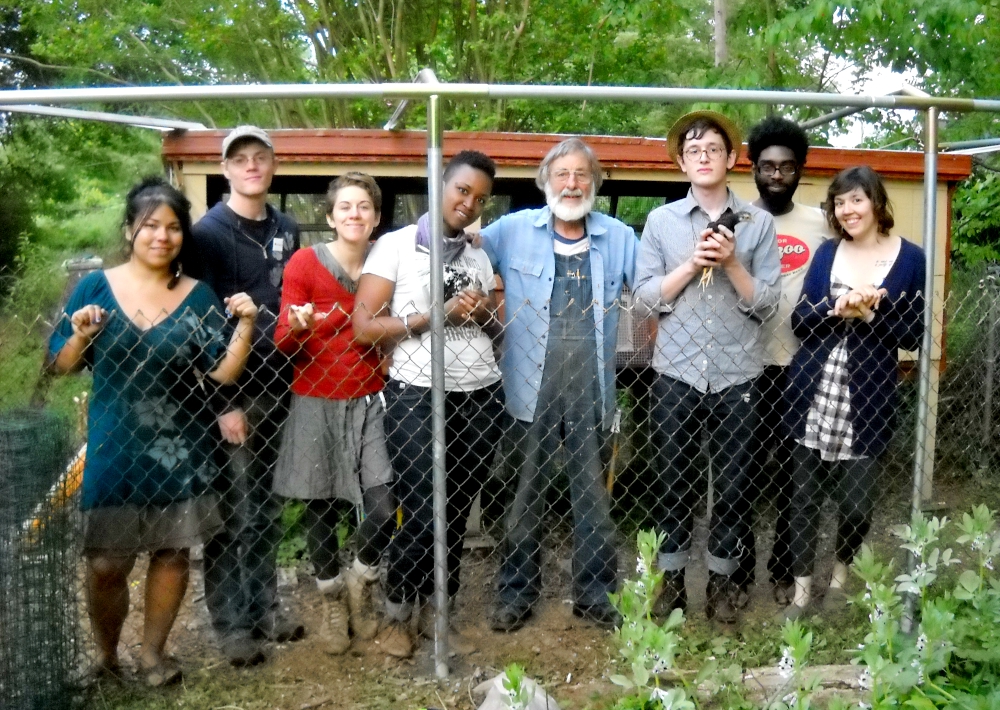
Karl Meyer (fourth from right) stands with other community members from the Nashville Greenlands Catholic Worker community in Tennessee in 2012. Meyer, now almost 81 years old, moved to Nashville in his 60s to focus on starting an urban farm, after decades of running a house of hospitality in Chicago. (Courtesy of Karl Meyer)
As advocates of decentralization, Catholic Worker co-founders Dorothy Day and Peter Maurin led by example rather than attempt to create a large organization structured around their ideas for transforming society.
Many of those who follow in their footsteps think both founders would be pleasantly surprised that the movement they started during the Great Depression is the inspiration for a loose network of nearly 250 communities today.
"I think Dorothy and Peter actually would be really happy with the movement. I'm sure they never imagined that we would be around 85 years later still trying to live out their initial vision," said Cleveland Catholic Worker Paula Miller.
In the Catholic Worker, the paper they first published in New York City on May 1, 1933, Day and Maurin advocated for the establishment of houses of hospitality, roundtable discussions, and farms where people could re-learn how to live on the land. The paper also had a strong emphasis on pacifism and workers' rights and recommended the practices of the works of mercy, voluntary poverty and manual labor.
Because the Catholic Worker emphasized personalism, a philosophy that prioritizes the human dignity of each individual and calls on people to care for their neighbors at a personal sacrifice, Day, Maurin and others who joined them soon began following their own advice to provide hospitality, organize discussions and set up a farm.
Hundreds of groups have followed their example in a movement that still resists becoming formalized and has had no clear leadership since Day's death in 1980.
The idea of "personal responsibility, doing what you can do, not relying on Holy Mother the State," attracts people to the movement, said Karl Meyer, a longtime Catholic Worker whose current community is Nashville Greenlands in Tennessee. "We try to influence government but we know we're relatively powerless. But we try to do what we can do to address these problems and set an example to better society."
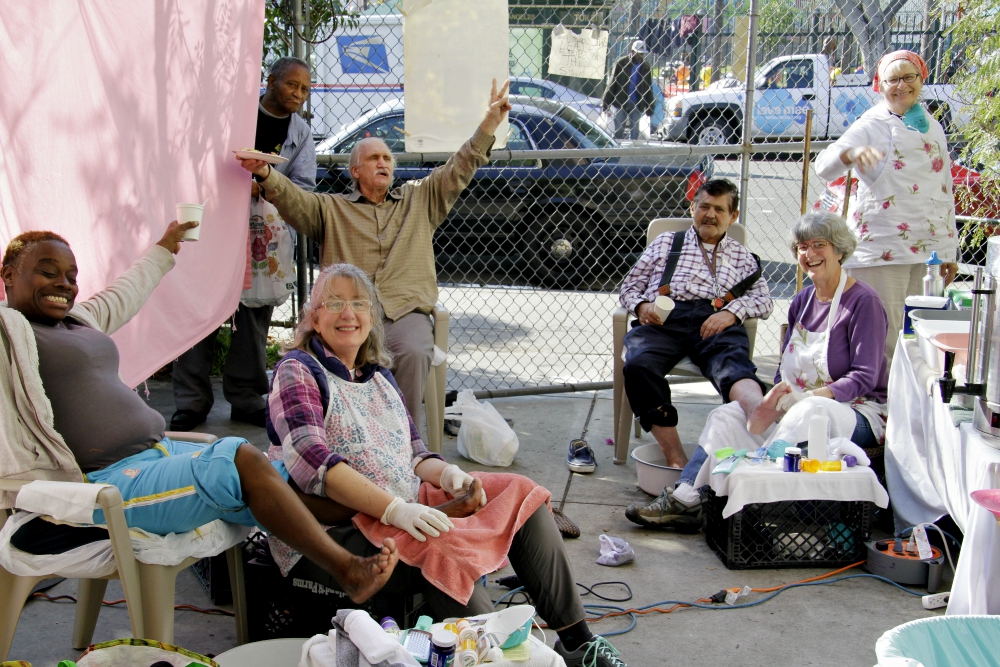
Volunteers provide foot care for patients during one of the Los Angeles Catholic Worker's weekly health outreach days. (Michael Wisniewski)
This decentralized, even anarchist, approach has led Catholic Worker communities to develop in a variety of formats and to carry out a spectrum of ministries that are limited only by their members' interests, resources and creativity.
Funded largely by individual donations and sometimes by the salaries Catholic Workers bring from outside jobs, some communities offer emergency shelter or transitional housing, while others offer a daytime drop-in center, meals, showers, medical clinics, case management, retreats, prayer services, workshops or some combination of those ministries. Farms usually provide some services but especially emphasize living sustainably.
Communities may also have a specific focus, such as hospice care or housing for immigrants, families, pregnant women, people with mental or physical health issues, human-trafficking victims, or LGBT youth.
It is also common for Catholic Workers to participate in activism and protests, sometimes including nonviolent civil disobedience, particularly in opposition to war but also related to causes such as immigration reform, anti-racism, anti-gentrification, pro-life issues and environmentalism.
This diversity wouldn't surprise Day and Maurin, said Steven Fisher, a member of Su Casa Catholic Worker in Chicago. "I think when they founded the Catholic Worker movement, that opportunity for diversity is inherently built into their ideas. So if things don't necessarily line up with their experience of the Catholic Worker as they created it, that wouldn't come as a shock."
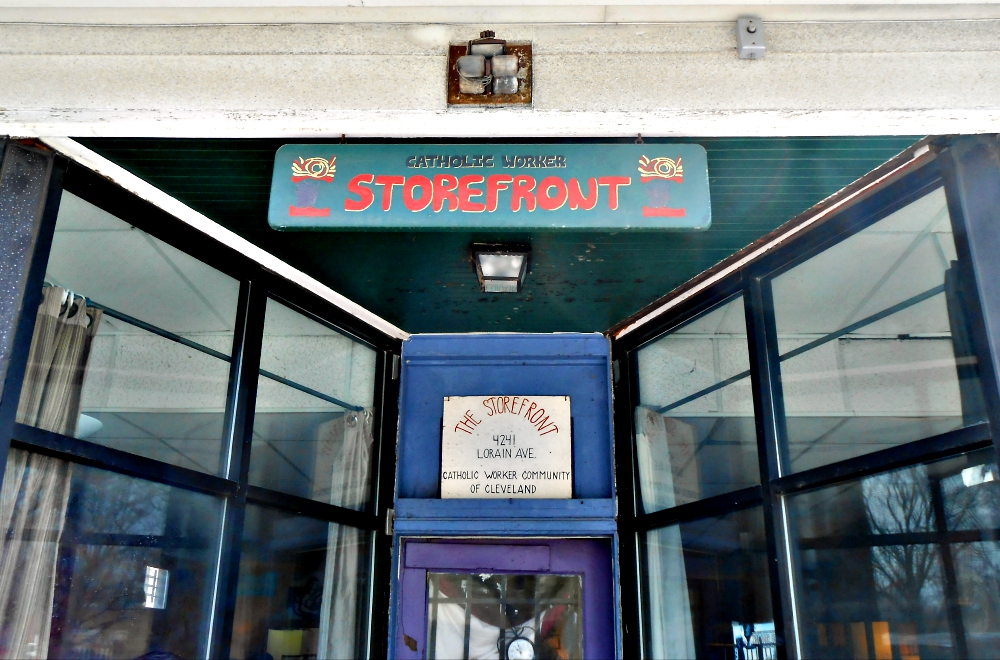
The entrance to the Cleveland Catholic Worker Storefront drop-in center, which offers food, coffee, art and movie nights, and an alternative health clinic (Courtesy of Cleveland Catholic Worker/Paula Miller)
It is also unsurprising that Catholic Workers often disagree with others in the movement or even with their founders, even while continuing to return to their vision for inspiration.
"Like any movement, you go back to your founders and you try to find the quote that does you best for your argument and with Dorothy Day you have 50 years to work from," said Frank Cordaro of the Des Moines, Iowa, Catholic Worker.
He pointed out that not only was Day not "stagnant," but her commitment to listening, avoiding coercion and not expelling anyone gave the movement permission to be flexible.
While Day didn't believe houses of hospitality were a good place to raise children, families have increasingly become part of the movement. Maurin and Day's philosophy that Catholic Workers shouldn't register with the government as nonprofits is more often followed, but not by all communities.
Day's reservations about "Plowshares" actions, nonviolent protests that include property destruction, also spark various reactions from Catholic Workers.
The actions have become the subject of intense debate in Catholic Worker publications and on a national Catholic Worker email group, run by Cordaro, with nearly 1,000 members — especially in the wake of a July 2017 announcement by Ruby Montoya and Jessica Reznicek, both members of Cordaro's community, that they sabotaged the Dakota Access Pipeline in an attempt to halt its construction.
More recently, Catholic Workers, including Day's granddaughter Martha Hennessey, were part of a Plowshares group that broke into the Kings Bay Nuclear Submarine Base in St. Marys, Georgia, April 4.
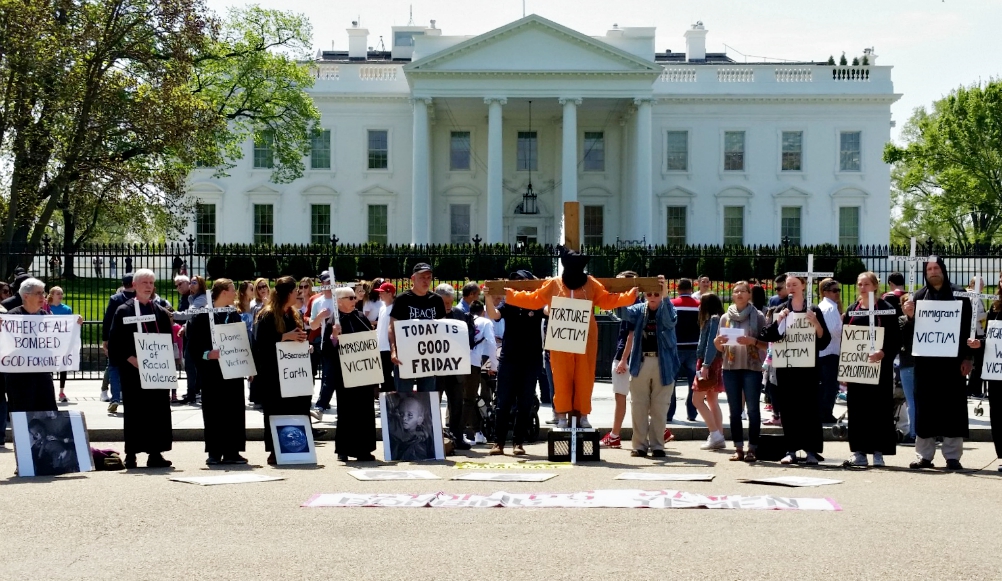
A 2017 Good Friday witness sponsored by the Dorothy Day Catholic Worker in Washington, D.C., protests "contemporary crucifixion" outside the White House. (Courtesy of Dorothy Day Catholic Worker/Art Laffin)
Plowshares actions are "still a big question in our movement but I would say more people than not support that today," said Brenna Cussen Anglada, a member of St. Isidore Catholic Worker Farm in Cuba City, Wisconsin.
At least as controversial is the issue of racism. An open letter by a group of young Catholic Workers from the Midwest called for a greater focus on anti-racism and described the Catholic Worker movement as a "racist institution." The letter was met with criticism and defenses of the movement's history of supporting people of color.
While the debate is sometimes "draining," said Cussen Anglada, one of the letter's signers, it is overall a good sign.
"We might disagree on how adequately or inadequately we've addressed it in the past, but I think everyone agrees that we haven't done as good of a job as we could have and that racism and white supremacy are present to some degree in our movement and it's something that we need to be continually working on," she said.
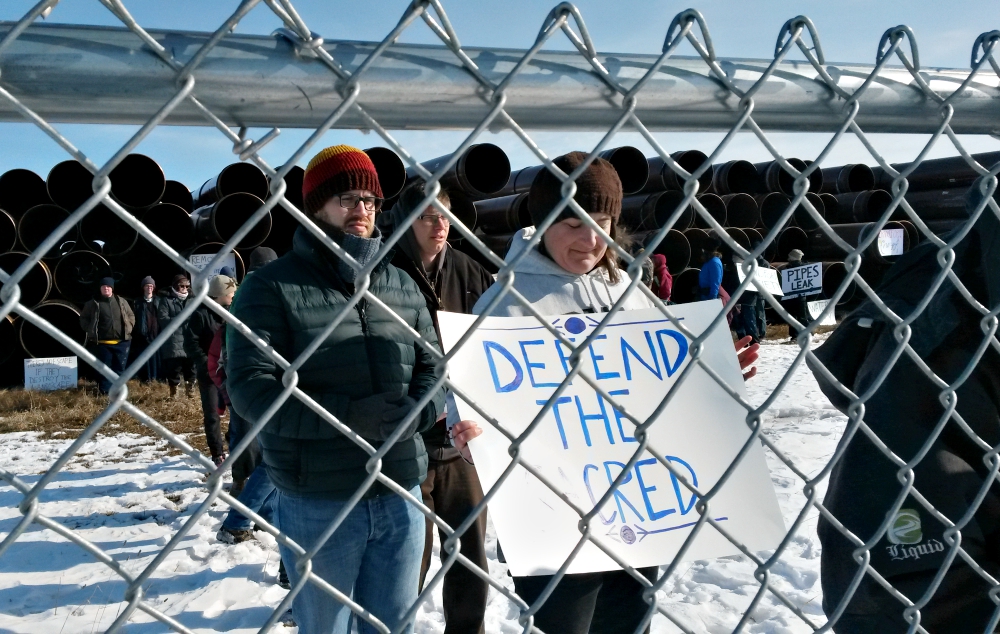
Brenna Cussen Anglada of St. Isidore Catholic Worker Farm heads a line of protesters risking arrest at a pipeline storage yard in Carlton County, Minnesota, April 9, as they approach the fence for a traditional Native American cleansing ritual known as smudging. The protest of a planned Line 3 pipeline project came at the end of the Midwest Catholic Worker Faith and Resistance Retreat in Duluth, Minnesota. (NCR photo/Maria Benevento)
It is both encouraging and rare "to find 60- and 70-year-olds and 20- and 30-year-olds in such constant dialogue with one another," Cussen Anglada added. "Even when it gets really tense, we're in it together and we're still in very good relationship with one another."
Intergenerational engagement is common within the Catholic Worker movement, where one typical format is for a small number of long-term members to provide stability while the bulk of a community is made up of others, often young people, who remain just a year or two.
As with nearly any aspect of the movement, there are exceptions. At the Cleveland Catholic Worker, many core community members have been together for decades because they live in their own homes or in community-owned buildings separate from the guest house, a format that prevents burnout, Miller said.
Meanwhile, at Su Casa, the most senior member of the community has been there for only a year and a half. But Fisher, who joined the community in August 2017, did not describe this situation as a disadvantage.
Su Casa finds it stability in "the people in the neighborhood who are familiar with Su Casa and have held Su Casa together," Fisher said. "We as a community are inheriting the work that past communities have done but also tailoring that identity to the needs of the current families" who receive hospitality at the house.

A copy of the Kairos newsletter for Su Casa Catholic Worker house in Chicago (Courtesy of Su Casa Catholic Worker/Steven Fisher)
The movement as a whole has also adjusted to the needs of current members, who many noted are becoming more religiously diverse despite the movement's name and its founders' deep connection to Catholicism.
But all-Catholic communities still exist. Art Laffin, a member of Dorothy Day Catholic Worker in Washington, D.C., wrote in an email to NCR that all of the current community members are "lifelong Catholics." He said his participation in the movement had helped him "know the seriousness of the situation in our world and to discern what changes and risks I should make in my own life to be faithful* to the Gospel."
Louise Zwick, a founding member of Casa Juan Diego in Houston, said her community has a strong Catholic identity, including a close connection to a local parish, hosting weekly Mass and basing its mission to care for undocumented immigrants on the Gospel.
"We know that the person who comes to us is not Joe Smith or José García but the Lord himself in disguise," she said, "and we really can't demand papers from the Lord."
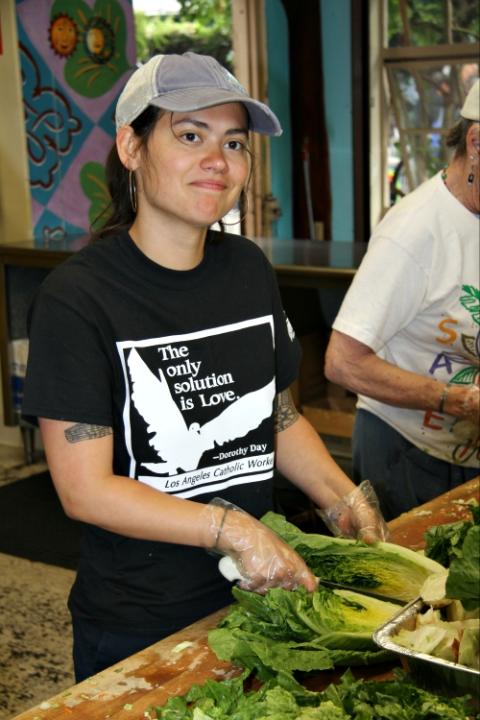
Food preparation at the Los Angeles Catholic Worker (Michael Wisniewski)
However, even these communities don't make Catholicism a requirement for those who might like to join, and the movement resonates with non-Catholics as well.
Kaleb Havens, a Los Angeles Catholic Worker who recently spent Lent fasting and chained to a fence to protest homelessness in his city, is not Catholic but described the Catholic Worker as the most accurate depiction of Christianity he has found because of its emphasis on putting faith into action.
Some communities, such as the Bloomington Catholic Worker in Indiana or the Martin Luther Catholic Worker in Milwaukee, are explicitly ecumenical. Others, like the Mennonite Worker in Minneapolis or even the Mormon Worker, a blog "devoted to Mormonism and Radical Politics," are associated with another specific faith tradition.
While Day thought Catholicism was superior to other religions, she still would have been "thrilled" with this turn of events, said Meyer, who knew Day from 1957 until her death.
Meyer, now almost 81 years old, moved to Nashville in his 60s to focus on starting an urban farm, after decades of running a house of hospitality in Chicago.
Although his community's description explicitly says it is "not based in prayer or religious doctrine," Meyer still identifies strongly with the Catholic Worker movement and wants to "pass on that radical vision of a different social order, a new society within the shell of the old" to around two dozen young organizers who have joined him.
That radical vision is still relevant, Meyer said. "The influence of Catholic Worker movement is the authenticity and relevance of the ideas. … It may be more relevant than it was in 1933."
The movement also seems to be growing. James Allaire, who runs the Catholic Worker Movement website, said he is made aware of eight to 10 new communities to add to the website's directory each year. Although his list isn't totally accurate, since he isn't always notified of communities' closure, the directory lists 216 U.S. and 33 international Catholic Worker communities.
An especially rapidly growing part of the movement is farming communities, an aspect of the Catholic Worker that has been present from the beginning but, until recently, was often neglected or unsuccessful. The directory currently lists 19 farms, and more urban houses have begun to add garden components.
Advertisement
"Environmental consciousness has a lot to do with it," said Meyer, "and the awareness of the importance of local food, environmental justice. Sixty years ago, we knew about emerging environmental problems and the burden of human population on Earth but it has really come forward much more strongly in the last few decades."
While responses to urban issues have often seemed most urgent, "all of our activism is often saying no to destructive things," said Cussen Anglada. The farms are "what we can say yes to, a new social order." The farms "point toward a way forward — living cooperatively, staying connected to land, having greater respect for creation and in a very concrete, tangible way."
The increased interest in farming shows that Maurin and Day's platform hasn't been abandoned, even if it hasn't been totally fulfilled, Havens said. "I think it's just all going to take a long time to change the way people live and think."
Maurin "would be happy today to see the kind of resurgence of Catholic Worker farms and getting back to the land and the green revolution that was part of the initial vision," Miller said, adding that the founders would also be happy to see the movement's continuing tradition of activism, discussion and works of mercy.
"We can't rely on the church. We can't rely on the government. We need to be taking care of each other, and then trying to change the systems that keep people oppressed. And that's really what we do, every day of our lives, by choice," Miller said.
[Maria Benevento is an NCR Bertelsen intern who previously worked at the Oakland Catholic Worker in California. Her email address is mbenevento@ncronline.org.]
*Art Laffin's quote has been corrected to change "faith" to "faithful"







